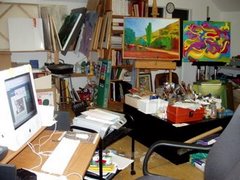
Master Elahi's glass workshop
Ostaad Elahi's workshop had already started work when I arrived at 7:00 AM. The weather was not as hot; I think it was only 90 degrees at 7:00 AM..... There was a total of fifteen people working; five grand masters, five intermediate masters, three apprentices, and two packers. Five had not shown up for work and Ostaad Elahi was going to let them go as soon as he finished production for his major order.

Thursday's glass unloaded from the kiln

More orders ready for packing
The five grand masters did all the major work such as preparing the form for the more complex glass shapes and putting the finishing touches at the end. These required constant placement of the blow pipe into the kiln, removing it, and cooling it, dipping it back in the hot kiln again, and then blowing, turning, and rubbing on metal. It took each one of the masters a few trips back and forth to the kiln, the rubbing tables, and the pools of water. There were eight to ten different kilns running. Each kiln had a separate function with different temperatures. After the basic shape of the glass was achieved by the master, and the temperature was right, he would give the blow pipe with the formed molten glass at the end of it to one of the apprentices who would warm it up a bit in one of the kilns and then take it to one of the intermediate masters.

Ostaad Elahi at work
The intermediate master would blow it some more, dip the form in a metal cube mold , blow it into a cube, twist it, pull it out, and then give it to one of the apprentices who would place it in one of the kilns to warm up again. The apprentice would then return the piece back to the intermediate master who would work on the shape a little more by rolling the blow pipe on a metal surface with the glass vessel sticking out in space, untouched by anything. Meanwhile, the apprentice retrieved some molten glass with another blow pipe to attach to the bottom of the vessel for removal. The intermediate master would dip his metal pliers in a container of water, drip some water onto the section attached to his blow pipe, press with his pliers, repeat a few times, and then tap on the section gently with the pliers until his blow pipe broke away from the vessel.

Intermediate master molding the glass in a metal rectangular cube
In the meantime, the vessel was attached at the bottom to the apprentices blow pipe who would roll his pipe in accordance with the master. All this required a lot of cooperation and silent understanding as to who had to do what task. From this point, the apprentice would take the vessel back to another kiln and roll it a bit to warm up again, then he would take the blow pipe with the glass piece attached to it to a master (not an intermediate one) who would in turn finish up the detail work. The vessel would then be handed to an apprentice who would place it in the cooling kiln.

The apprentices learning from the master
Five intermediate masters did the less complex work. Three apprentices did all the basic work. One apprentice had just started two days ago, but he was very quick and Ostaad Elahi said that this apprentice had just finished a two year college with a diploma in accounting and had to do military service in six months and had decided to apprentice as a glass blower for the remaining time he had. Ostaad Elahi said that this apprentice learned fast because he was educated. He did know a lot for someone who had started only a few days ago. He was twenty one years old and when he stopped for a cigarette, I went over and scolded him.

The fire is placed directly in the mold
I spent the morning at the workshop taking notes, taking pictures, and videotaping. The five grand masters were the ones from last year, but the intermediate masters were not the ones I had observed last year. I asked Ostaad Elahi about them, and he mentioned that the ones who were from Afghanistan had to go back to their country. The Iranian government has told all Afghan refugees that they need to go back now that their country is recovering. So, Ostaad Elahi gave his Afghan workers signed papers attesting them as glassblowers, and hired new ones. Each apprentice earns $5 a day. Very little money for so much work. I think the intermediate master may fetch as much as $15-20 a day, but I did not ask.

Ostaad Najaf Nejhad at work
If I feel comfortable, I will ask Ostaad Elahi on Monday when I will be interviewing him after the shop stops production at 3 PM. The information on the earnings of the apprentices was given to me by one of the masters. They feel comfortable with me and would come over and talk to me on their own. It is nice to have gained their ease around me. I asked Ostaad Elahi if he had any daughters. He said he did, and that they were interested in glassblowing and would join him in his workshop as soon as they were old enough.

